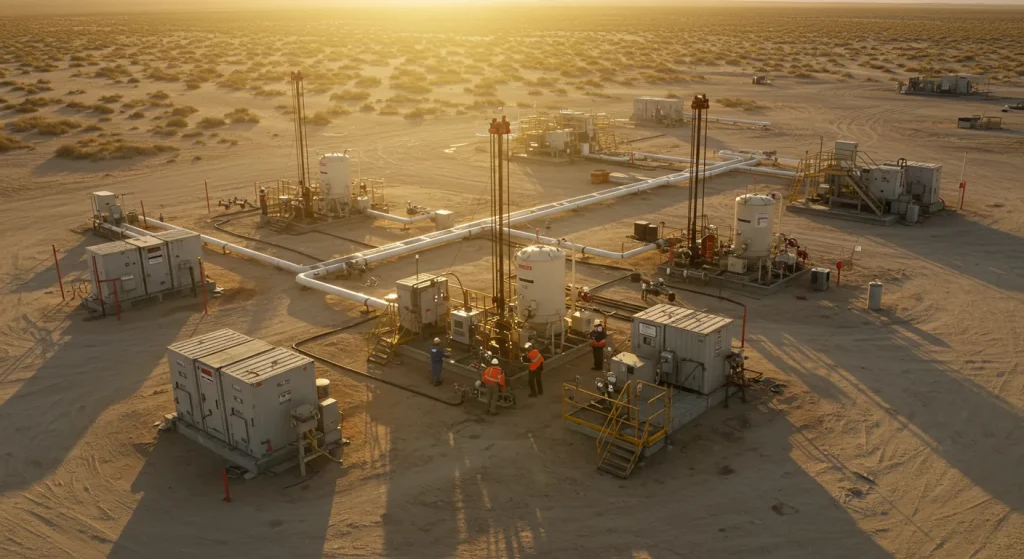
## Produced Water Treatment Systems: Turning Waste into a Resource
Produced water, a byproduct of oil and gas extraction, is a complex mixture of water, hydrocarbons, dissolved solids, and other contaminants. Historically considered a waste product, the sheer volume of produced water generated globally is staggering, presenting both an environmental challenge and a potential resource opportunity. This has fueled the development and implementation of sophisticated **Produced Water Treatment Systems (PWTS)**.
**The Challenge: Understanding Produced Water’s Complexity**
The composition of produced water varies significantly depending on the geological formation, extraction method, and age of the well. Common contaminants include:
* **Oil and Grease:** Emulsified and free-floating hydrocarbons.
* **Total Dissolved Solids (TDS):** Salts, minerals, and other inorganic compounds.
* **Suspended Solids:** Sand, silt, and other particulate matter.
* **Heavy Metals:** Mercury, arsenic, lead, and other toxic elements.
* **Radioactive Materials:** Naturally Occurring Radioactive Material (NORM).
* **Production Chemicals:** Added during the extraction process.
Untreated produced water can pose significant environmental risks, including groundwater contamination, soil degradation, and harm to aquatic ecosystems. Therefore, effective treatment is crucial.
**The Solution: A Multi-faceted Approach to Treatment**
PWTS employ a combination of physical, chemical, and biological processes to remove contaminants and render the water suitable for reuse or disposal. The specific technologies used depend on the desired water quality and the intended application. Common treatment methods include:
* **Primary Treatment:** Focuses on removing bulk oil, grease, and solids.
* **Gravity Separation:** Oil and water separate based on density differences.
* **Hydrocyclones:** Centrifugal force separates oil and solids from water.
* **Skimmers:** Remove surface oil layers.
* **Filtration:** Removes suspended solids.
* **Secondary Treatment:** Targets dissolved and emulsified oil, as well as remaining solids.
* **Induced Gas Flotation (IGF):** Microbubbles attach to oil droplets, causing them to float to the surface for removal.
* **Dissolved Air Flotation (DAF):** Similar to IGF, but uses dissolved air instead of induced gas.
* **Media Filtration:** Removes finer particles using different types of filter media.
* **Chemical Treatment:** Coagulation, flocculation, and pH adjustment to enhance solids removal.
* **Tertiary Treatment:** Achieves higher water quality for specific reuse applications.
* **Membrane Filtration:** Reverse osmosis (RO), nanofiltration (NF), and ultrafiltration (UF) remove dissolved solids and other contaminants.
* **Adsorption:** Activated carbon or other materials remove dissolved organic compounds.
* **Ion Exchange:** Removes specific ions, such as hardness or heavy metals.
* **Biological Treatment:** Uses microorganisms to break down organic contaminants.
**The Benefits: Environmental Stewardship and Resource Recovery**
Investing in effective PWTS offers numerous benefits:
* **Environmental Protection:** Minimizes the risk of water and soil contamination.
* **Regulatory Compliance:** Meets increasingly stringent environmental regulations.
* **Water Conservation:** Reduces the demand for freshwater by reusing treated produced water.
* **Cost Savings:** Reduces disposal costs and potentially generates revenue from water sales.
* **Resource Recovery:** Recovers valuable hydrocarbons and other resources from produced water.
**The Future: Innovation and Sustainability**
The field of produced water treatment is constantly evolving, with ongoing research and development focused on:
* **Developing more efficient and cost-effective treatment technologies.**
* **Optimizing treatment processes for specific water compositions.**
* **Minimizing energy consumption and waste generation.**
* **Exploring new reuse applications for treated produced water.**
* **Integrating PWTS into a circular economy model.**
**Reuse Applications:**
Treated produced water can be used for a variety of purposes, including:
* **Agricultural Irrigation:** Requires careful monitoring and control of salinity and other parameters.
* **Industrial Cooling:** Can reduce the demand for freshwater in power plants and other industrial facilities.
* **Dust Suppression:** On roads and construction sites.
* **Hydraulic Fracturing (Fracking):** Reduces the need for freshwater in fracking operations.
* **Aquifer Recharge:** Replenishes groundwater supplies.
* **Potable Water Production:** Requires advanced treatment and rigorous monitoring.
**Conclusion:**
Produced water treatment systems are essential for responsible oil and gas production. By effectively treating produced water, companies can minimize environmental risks, comply with regulations, conserve water resources, and potentially generate new revenue streams. As the demand for energy and water continues to grow, the development and implementation of innovative and sustainable PWTS will be crucial for ensuring a cleaner and more sustainable future. The focus should be on moving from considering produced water as a waste product to viewing it as a valuable resource.